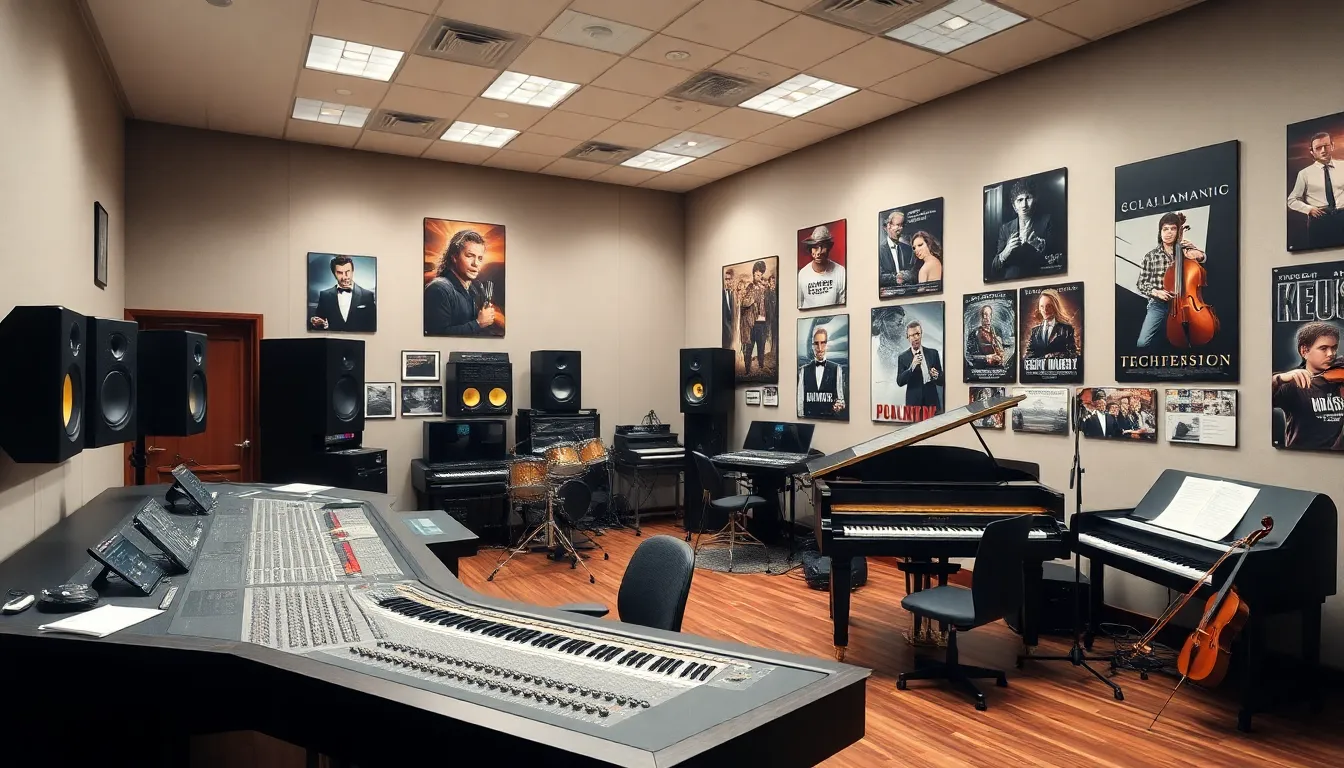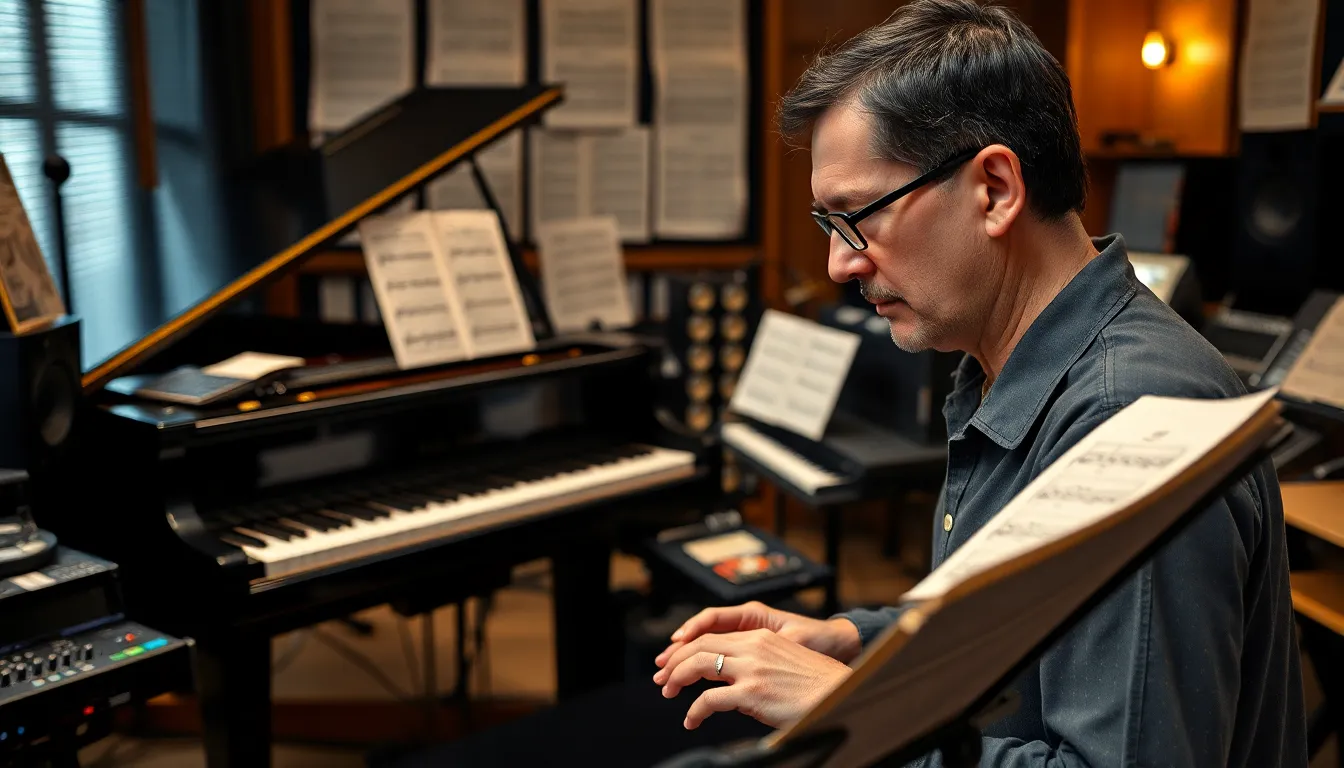Table of Contents
ToggleEvery great film has its unforgettable moments, but what truly elevates those scenes to legendary status? The answer often lies in the subtle yet powerful use of musical motifs. These catchy little tunes, like the earworm that just won’t quit, weave their way through the narrative, creating emotional connections that linger long after the credits roll.
Overview of Musical Motifs in Film
Musical motifs serve as fundamental elements in film scoring. They comprise short, recurring melodies that enhance storytelling. These motifs convey emotions and themes central to the plot. Various films employ such motifs to create cohesiveness and deepen audience engagement.
Certain motifs evoke specific characters or events, allowing viewers to immediately connect with narrative developments. For example, in Star Wars, the “Imperial March” is synonymous with Darth Vader, signaling his presence and menacing nature. Similarly, Jaws uses its iconic two-note motif to build suspense and anticipation of the shark’s arrival.
The repetition of musical motifs reinforces the overall theme, forging stronger emotional ties. When audiences hear a motif, they subconsciously recall previous scenes related to it. This technique builds familiarity and enriches the viewing experience.
Directors and composers often collaborate to ensure motifs align with the film’s emotional arc. Decisions on placement and variation of these motifs can elevate crucial moments, making them unforgettable. Notable composers like John Williams and Hans Zimmer exemplify the use of motifs, crafting scores that resonate with audiences long after viewing.
Undoubtedly, musical motifs play an essential role in film. They bridge the gap between visual storytelling and auditory experience, enhancing dynamic moments and ensuring memorable connections. With careful consideration, filmmakers can wield these motifs to great effect, establishing a lasting impact.
Importance of Musical Motifs

Musical motifs play a crucial role in film. They evoke emotions and enhance storytelling, providing depth to the viewing experience.
Emotional Resonance
Musical motifs evoke strong emotional responses. They amplify key moments in the narrative, making them memorable. Audiences often feel heightened suspense or joy when familiar melodies reappear. Themes like love or danger can be portrayed effectively through these recurring tunes. Films such as E.T. the Extra-Terrestrial exemplify this, where the motif captures the essence of childhood wonder and longing. Each time the motif plays, it connects viewers to the protagonist’s journey, solidifying emotional ties. The bond created through music often leaves a lasting impression that resonates long after the credits roll.
Character Development
Musical motifs contribute significantly to character development. Specific melodies highlight traits or arcs of characters throughout the film. For instance, the “Hedwig’s Theme” in Harry Potter is intrinsically linked to Harry, symbolizing his magic and growth. Audiences recognize these motifs as reflective of character changes. When a character faces challenges or transformations, the associated motif evolves, signaling growth. This technique deepens engagement with the storyline and creates more profound connections. Composers like Ennio Morricone and Hans Zimmer expertly use motifs to enhance character narratives, making their journeys more compelling.
Types of Musical Motifs
Musical motifs vary in complexity and purpose, each serving a distinct role in enhancing film narratives. Understanding these types can deepen one’s appreciation of film scores.
Leitmotif
Leitmotifs are specific musical phrases associated with particular characters, places, or ideas. Composers use them to create identity and recognition, allowing audiences to connect emotions with characters. For example, “The Ring” theme in The Lord of the Rings signifies power and temptation, instantly evoking critical plot points. Recognition builds as the motif recurs, deepening emotional engagement. John Williams employs this effectively in Star Wars, linking the “Force theme” to moments of hope and heroism. Such associations enrich the storytelling, allowing viewers to recall previous scenes and emotional arcs.
Thematic Variations
Thematic variations refer to alterations or adaptations of core motifs throughout a film. These adaptations may involve changes in tempo, instrumentation, or style, providing dynamic shifts while maintaining thematic cohesion. Such variations allow composers to reflect character growth or evolving plot lines. For instance, in Harry Potter, variations of “Hedwig’s Theme” accompany different emotional tones, from joy to tension. Compliance with the mood of scenes enhances the audience’s emotional connection. This technique enriches the overall viewing experience, demonstrating composers’ creativity in reinforcing narratives through subtle musical shifts.
Iconic Examples of Musical Motifs in Film
Musical motifs often serve as memorable signatures in cinema, with composers like John Williams and Hans Zimmer leading the way in creating iconic scores.
John Williams’ Scores
John Williams excels at crafting memorable motifs that resonate with audiences. His use of the “Imperial March” in Star Wars instantly evokes the presence of Darth Vader. Another notable example is the “Force theme,” which captures moments of hope throughout the saga. This technique reinforces character arcs and emotional beats, establishing a strong connection between the audience and the narrative. Williams’ ability to intertwine musical phrases within a film’s emotional landscape elevates storytelling, making his scores timeless masterpieces.
Hans Zimmer’s Innovations
Hans Zimmer introduces innovative techniques that enhance cinematic storytelling. His score for Inception features the iconic “braaam” sound, which builds tension and serves as a motif, linking various plot elements. Zimmer skillfully adapts melodies throughout a film, as seen in Interstellar, where themes evolve to reflect the characters’ journeys. These transformative motifs deepen emotional engagement, creating an immersive auditory experience. Through experimentation and collaboration, Zimmer consistently pushes boundaries, exploring new auditory landscapes that enhance film narratives.
Analyzing the Impact of Musical Motifs
Musical motifs significantly shape the emotional landscape of films. Through repeated melodies, filmmakers establish connections between scenes and character arcs. Directors use these sonic cues to enhance storytelling while maintaining audience engagement.
Heightened emotions arise from specific motifs linked to pivotal moments in a film. The “Imperial March,” associated with Darth Vader, creates a sense of impending doom, while the two-note motif from Jaws generates suspense. Each instance heightens tension, drawing viewers deeper into the narrative.
Character development often hinges on the recurrence of these motifs. For instance, “Hedwig’s Theme” resonates with Harry Potter’s journey, symbolizing his growth and magical experiences. Recognition of these motifs fosters a bond between characters and viewers, enriching the cinematic experience.
Different types of motifs, such as leitmotifs, provide a deeper layer of meaning. Each theme often signifies specific characters or ideas, enhancing emotional resonance. The “Ring” theme from The Lord of the Rings encapsulates fear and temptation, while the “Force theme” in Star Wars symbolizes hope. By integrating these themes, composers create an auditory identity for characters.
Thematic variations also breathe life into storytelling. Altered motifs reflect character evolution or plot progression, maintaining audience interest. Variations of “Hedwig’s Theme” exemplify how music adapts to narrative changes, reinforcing emotional depth.
Composers like John Williams and Hans Zimmer exemplify mastery over musical motifs. Williams crafts memorable themes that resonate, enriching the film’s emotional arc. Zimmer, on the other hand, employs innovative techniques, transforming the auditory experience and deepening audience connection. Each composer pushes the boundaries of film scoring, showcasing the indispensable role of musical motifs in cinema.
Musical motifs are essential in creating memorable cinematic experiences. They not only enhance storytelling but also forge emotional connections that resonate with audiences long after the credits roll. By weaving these motifs into the fabric of a film, composers like John Williams and Hans Zimmer elevate the narrative and deepen character arcs.
Through the clever use of leitmotifs and thematic variations, filmmakers can evoke specific emotions and highlight pivotal moments. This dynamic interplay between music and visuals enriches the viewer’s journey, making each film a unique auditory and emotional experience. Ultimately, musical motifs stand as a testament to the power of sound in storytelling, leaving an indelible mark on the hearts of audiences.



